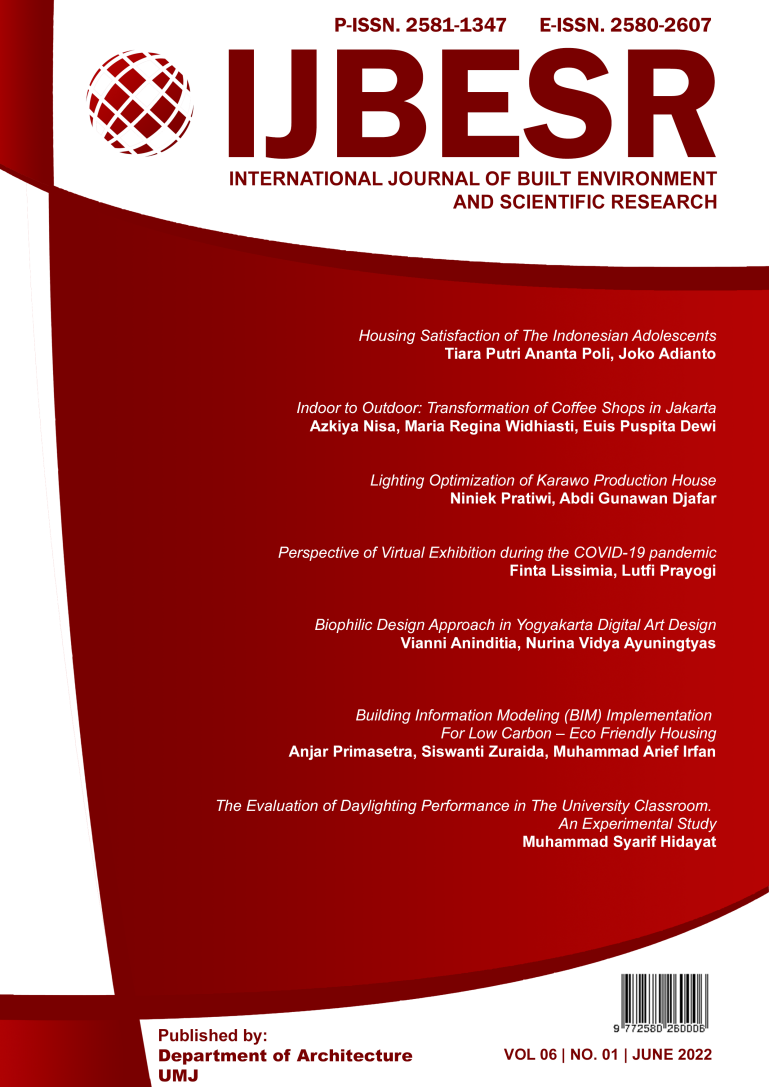The Evaluation of Daylighting Performance in The University Classroom. An Experimental Study
DOI:
https://doi.org/10.24853/ijbesr.6.1.73-82Keywords:
natural lighting, artificial lighting, curtains, measuring point, classroomAbstract
To obtain natural light in the room course need aperture wide. However, it will cause the room to become hot because radiation also can come in. To reduce the radiation, the curtains are used to reduce such radiation. This resulted in the lighting level in the classroom decreases. When this is the case, then artificial lighting is needed. This study aims to optimize natural and artificial light in classrooms that use a curtain. The results showed that the level of natural lighting that can reach all of the space obtained by opening all the curtains. At the point of measuring in the front (near the board) reached 284 to 325 lux. However, on the side of the window gets very high light from 3100 to 3340 lux (TU 10, 11, and 12). If the blinds partially open (50%) the light only reaches the middle of the room (TU 7,8,9). The use of lights is not a lot of role because of the level of exposure of the lamp not according to the standardReferences
Achsani, R. A., Wonorahardjo, S., & Soelami, F. X. N. (2018). A Vision of Daylight Technologies for High-Rise Residential Building in Tropic. IOP Conference Series: Earth and Environmental Science, 152(1). https://doi.org/10.1088/1755-1315/152/1/012013
Axarli, K., & Tsikaloudaki, K. (2007). Enhancing Visual Comfort in Classrooms Through Daylight Utilization. CLIMA 2007 Wellbeing Indoors, 3(1), 8. https://doi.org/10.1016/S0921-4526(96)00718-1
Badan Standardisasi Nasional. (2001). Tata cara perancangan sistem pencahayaan buatan pada bangunan gedung . Sni 03-6575-2001. https://doi.org/10.1016/j.energy.2016.11.038
Binarti, F. (2009). Energy-efficient window for classroom in warm tropical area. IBPSA 2009 - International Building Performance Simulation Association 2009, 1655–1662. Retrieved from https://www.scopus.com/inward/record.uri?eid=2-s2.0-84870184310&partnerID=40&md5=f0a0455750372f0995fe609b134a3977
Bustamante, W., Vera, S., Prieto, A., & Vásquez, C. (2014). Solar and lighting transmission through complex fenestration systems of office buildings in a warm and dry climate of Chile. Sustainability (Switzerland), 6(5), 2786–2801. https://doi.org/10.3390/su6052786
Carlos, J. S., & Corvacho, H. (2017). Assessing Thermal Comfort Due to a Ventilated Double Window. IOP Conference Series: Materials Science and Engineering, 245(4). https://doi.org/10.1088/1757-899X/245/4/042004
Costanzo, V., Evola, G., & Marletta, L. (2017). A Review of Daylighting Strategies in Schools: State of the Art and Expected Future Trends. Buildings, 7(2), 41. https://doi.org/10.3390/buildings7020041
Fadzil, S. F. S., Al-Tamimi, N. A., Abdullah, A., & Harun, W. M. W. (2010). Wall Window Ratio (WWR) and its Influence on Internal Air Temperatures and Natural Light Level in Glazed Room in the Tropics. ICSAUD 2010 Sustainable Architecture and Urban Design, 3-4 March 2010, (November).
Garcia-Hansen, V. (2006). Innovative daylighting systems for deep-plan commercial buildings. Faculty of Built Environment and Engineering, (Queensland University). Retrieved from http://eprints.qut.edu.au/16709/
Heschong, L., Wright, R. L., & Okura, S. (2002). Daylighting Impacts on Retail Sales Performance. Journal of the Illuminating Engineering Society, 31(2), 21–25. https://doi.org/10.1080/00994480.2002.10748389
Jalilzadehazhari, E. (n.d.). Windows and blinds selection for enhancing subjective well-being Licentiate thesis.
Kolås, T. (2013). Performance of Daylight Redirecting Venetian Blinds for Sidelighted Spaces at High Latitudes. Retrieved from http://ntnu.diva-portal.org/smash/record.jsf?pid=diva2:683234
Lim, Y.-W., & Ahmad, M. H. (2013). Daylighting as a Sustainable Approach for High Rise Office in the Tropics. International Journal of Real Estate Studies, 8(2), 1–15.
M. Al-Tamimi, N. A., Syed Fadzil, S. F., & Wan Harun, W. M. (2011). The Effects of Orientation, Ventilation, and Varied WWR on the Thermal Performance of Residential Rooms in the Tropics. Journal of Sustainable Development, 4(2). https://doi.org/10.5539/jsd.v4n2p142
Mahdavi, A., Rao, S. P., & Inangda, N. (2013). Parametric Studies on Window-To-Wall Ratio for Day lighting Optimisation in High-Rise Office Buildings in Kuala Lumpur , Malaysia. Journal of Design and Built Environment, 12(June), 1–8.
Provinsi DKI Jakarta Tahun 2012, P. G. N. 38. (2012). Peraturan Gubernur No. 38 Tahun 2012.
Shen, H., Tzempelikos, A., Atzeri, A. M., Gasparella, A., & Cappelletti, F. (2015). Dynamic Commercial Façades versus Traditional Construction: Energy Performance and Comparative Analysis. Journal of Energy Engineering, 141(4), 04014041. https://doi.org/10.1061/(ASCE)EY.1943-7897.0000225
Tzempelikos, A., & Athienitis, A. K. (2007). The impact of shading design and control on building cooling and lighting demand. Solar Energy, 81(3), 369–382. https://doi.org/10.1016/j.solener.2006.06.015
Van Den Wymelenberg, K. (2012). Patterns of occupant interaction with window blinds: A literature review. Energy and Buildings, 51, 165–176. https://doi.org/10.1016/j.enbuild.2012.05.008
Yang, Q., Liu, M., Shu, C., Mmereki, D., Uzzal Hossain, M., & Zhan, X. (2015). Impact Analysis of Window-Wall Ratio on Heating and Cooling Energy Consumption of Residential Buildings in Hot Summer and Cold Winter Zone in China. Journal of Engineering (United States), 2015. https://doi.org/10.1155/2015/538254







